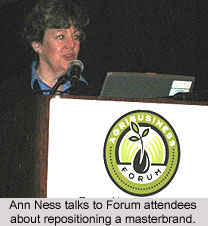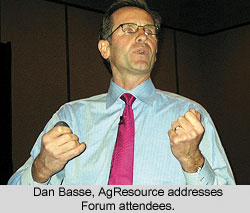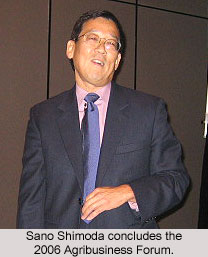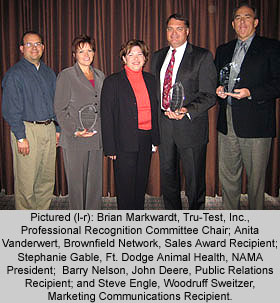Producers Who Have Adapted
 Agriculture is going through a dramatic change. Don Wick, Red River Farm Network, led a panel discussion on Tuesday, November 14, on how large producers are helping the agriculture industry keep up with these changes and how they are becoming a driving influence for suppliers. Panel members included John Vrieze and Tyler Bruch. Wick has been in farm broadcasting for 25 years and is a two-time winner of the “Oscars in Agriculture” for excellence in agricultural journalism. Wick is also a past president of the National Association of Farm Broadcasting and is a columnist for DairyStar.
Agriculture is going through a dramatic change. Don Wick, Red River Farm Network, led a panel discussion on Tuesday, November 14, on how large producers are helping the agriculture industry keep up with these changes and how they are becoming a driving influence for suppliers. Panel members included John Vrieze and Tyler Bruch. Wick has been in farm broadcasting for 25 years and is a two-time winner of the “Oscars in Agriculture” for excellence in agricultural journalism. Wick is also a past president of the National Association of Farm Broadcasting and is a columnist for DairyStar.
 John Vrieze is in partnership with Emerald and Baldwin Dairys in Wisconsin; he also serves on the board of the Russian Farm Community Project that operates a 500-cow dairy 60 miles north of Moscow. Vrieze is a third-generation dairy producer who in 1990 went into Russia to explore the options and in 2001 built the 500-cow dairy. His operation is one of the highest milk producers in Russia. He is currently building a 3,200-cow dairy facility on 9,000 acres of land in southern Siberia.
John Vrieze is in partnership with Emerald and Baldwin Dairys in Wisconsin; he also serves on the board of the Russian Farm Community Project that operates a 500-cow dairy 60 miles north of Moscow. Vrieze is a third-generation dairy producer who in 1990 went into Russia to explore the options and in 2001 built the 500-cow dairy. His operation is one of the highest milk producers in Russia. He is currently building a 3,200-cow dairy facility on 9,000 acres of land in southern Siberia.
The Emerald Dairy in Wisconsin includes a Transition Management Facility which is a pre and post natal care facility for cows. They have about 3,000 calvings per year at the facility and have a contract with the University of Minnesota’s College of Veterinarian Medicine to expose students to this calving facility. Next to the facility is a lagoon with about 11-12 million gallons of manure for which they have built a Mixed Plug-Flow Anaerobic Digester. In addition, they have also built a Gas Clarification Facility which takes the carbon dioxide and hydrogen sulfide out of the bio gas and leaves them with about 95% methane gas which is natural gas. They are producing about 100,000 cubic feet of natural gas per day and now have a contract with 3M who will buy the natural gas.
Emerald Dairy is also working on the Omega 3 project. They have tripled the amount of Omega 3 in milk which has huge advantages for cardiac health care. It’s been suggested that Omega 3 is brain food, not only for brain development for children, but for staving off Alzheimer’s.
 Tyler Bruch left his family farm in Emmetsburg, Iowa, after graduating from Iowa State University four years ago to start a farming operation in Bahia, Brazil. Bruch currently farms about 11,000 acres of soybeans, cotton and popcorn. Bruch is the owner and CEO of Global Ag Investments, a U.S. based private equity fund that allows U.S. investors to invest into U.S. managed agriculture in Brazil. He is also a partner in Global Ag Bio Diesel which is a 15 million gallon plant under formation that is due to break ground in February 2007. This plant will use cotton and soybean seed for bio diesel and will be sold to the local market. Bruch is also a silent partner with his brother and parents on their farm in Emmetsburg, Iowa. There they farm about 3,500 acres.
Tyler Bruch left his family farm in Emmetsburg, Iowa, after graduating from Iowa State University four years ago to start a farming operation in Bahia, Brazil. Bruch currently farms about 11,000 acres of soybeans, cotton and popcorn. Bruch is the owner and CEO of Global Ag Investments, a U.S. based private equity fund that allows U.S. investors to invest into U.S. managed agriculture in Brazil. He is also a partner in Global Ag Bio Diesel which is a 15 million gallon plant under formation that is due to break ground in February 2007. This plant will use cotton and soybean seed for bio diesel and will be sold to the local market. Bruch is also a silent partner with his brother and parents on their farm in Emmetsburg, Iowa. There they farm about 3,500 acres.
Why farm in other countries? Bruch says because of competition. Land prices in Iowa were around $150-$180 per acre to rent when he graduated, where as in Brazil it was around $27-$30 per acre to rent. The same is true in Russia, the land is affordable. Could anything keep these farmers from going to other countries to farm? “No,” says Bruch. The ability to increase acres to support additional farmily members is the limiting factor in the U.S. “In our area to expand, that means you have to walk over the neighbors to do it and I’m not willing to do that.” Bruch says there is an unlimited land base in Brazil and they are renting properties that have been established and in production for 10-12 years for $25-30 per acre on 60 year contracts.
Most of the commodities produced by Vrieze and Bruch are domestic, with the exception of Bruch whose cotton is about 50% domestic and 50% export. Vrieze says that the Federation of Russia put up trade barriers on cheap poultry coming into the country as a way to revitalize the poultry industry. There has been a huge number of poultry buildings built, including in southern Siberia. So it’s a ready made market for the soybeans he produces. Also, Russians love dairy products and even have more dairy selections than in the U.S., making it an easy commodity to fill.
Special thanks to the Cattlemen’s Beef Board for sponsoring this session.
 Ann Ness, Vice President of Corporate Brand Management at Cargill, presented Repositioning the Masterbrand: The Cargill Case Study at the Forum.
Ann Ness, Vice President of Corporate Brand Management at Cargill, presented Repositioning the Masterbrand: The Cargill Case Study at the Forum. Mike Adams, host of AgriTalk, hosted a panel discussion on Bio fuels, Wednesday, November 15, at the Forum. The session was broadcast live on AgriTalk through 70 stations in 20 states and on the AgriTalk web site. Panel members included: Richard Hahn, former president and CEO of Farmers National Company; Rick Tolman, CEO of the National Corn Growers Association; Kendell Keith, president of the National Feed and Grain Association; and Neil Dierks, CEO of the National Pork Producers Council.
Mike Adams, host of AgriTalk, hosted a panel discussion on Bio fuels, Wednesday, November 15, at the Forum. The session was broadcast live on AgriTalk through 70 stations in 20 states and on the AgriTalk web site. Panel members included: Richard Hahn, former president and CEO of Farmers National Company; Rick Tolman, CEO of the National Corn Growers Association; Kendell Keith, president of the National Feed and Grain Association; and Neil Dierks, CEO of the National Pork Producers Council. Each panel member described their background and what they are presently doing in the area of bio fuels. The panel presented and dispelled myths about bio fuels including: ethanol causing a supply demand imbalance; ethanol diverts corn away from food markets; ethanol causes unprecedented corn prices; and ethanol takes more energy.
Each panel member described their background and what they are presently doing in the area of bio fuels. The panel presented and dispelled myths about bio fuels including: ethanol causing a supply demand imbalance; ethanol diverts corn away from food markets; ethanol causes unprecedented corn prices; and ethanol takes more energy. Sano Shimoda, president and founder of BioScience Securities, hosted the panel discussion Food, Fuel & Feed – Frontiers of Change, on Wednesday, Nov. 15. Panel members included, Dan Basse, founder and president of AgResource; Hugh Whaley, senior vice president of Osborn & Barr Communications; and Lyle Orwig, CEO of Charleston Orwig.
Sano Shimoda, president and founder of BioScience Securities, hosted the panel discussion Food, Fuel & Feed – Frontiers of Change, on Wednesday, Nov. 15. Panel members included, Dan Basse, founder and president of AgResource; Hugh Whaley, senior vice president of Osborn & Barr Communications; and Lyle Orwig, CEO of Charleston Orwig. Sano Shimoda, BioScience Securities, concluded the 2006 Agribusiness Forum with “The Final Frontier – Where are we Headed?” on November 15.
Sano Shimoda, BioScience Securities, concluded the 2006 Agribusiness Forum with “The Final Frontier – Where are we Headed?” on November 15. The Agri-Business Educational Foundation (ABEF) hosted a Casino Night on Tuesday, November 14, during the Agribusiness Forum Welcome Reception. Proceeds from the Casino Night benefit the ABEF in support of the NAMA Student Careers Program.
The Agri-Business Educational Foundation (ABEF) hosted a Casino Night on Tuesday, November 14, during the Agribusiness Forum Welcome Reception. Proceeds from the Casino Night benefit the ABEF in support of the NAMA Student Careers Program. The recipients of the NAMA Professional Development Awards of Excellence were honored at a luncheon on Wednesday, November 15, at the Agribusiness Forum.
The recipients of the NAMA Professional Development Awards of Excellence were honored at a luncheon on Wednesday, November 15, at the Agribusiness Forum.